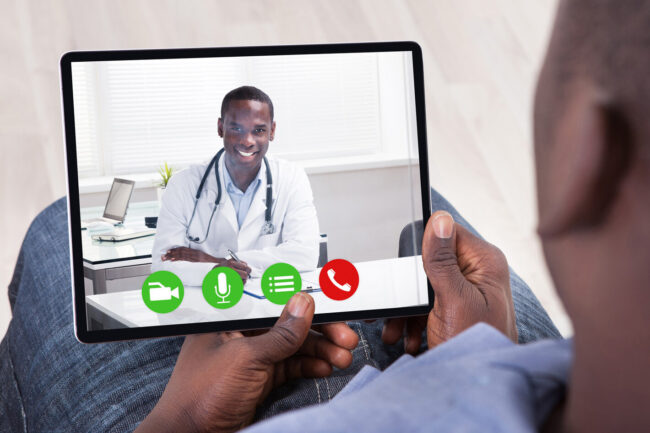Anyone with chronic medical issues should see their doctor on a frequent basis. Keeping up regular appointments is very important when it comes down to effective well-being. The fact is that you, as the patient, are in charge of your own health and the decisions you make have a significant impact on the outcomes and quality of life. During the COVID-19 pandemic, many people are reluctant to visit their doctors and it’s not hard to understand why. After all, you could be around people who have a probable case of the virus. Wearing personal protective equipment, practicing physical distancing, and using a hand sanitizer can help mitigate coronavirus risks, but maybe you’re not willing to take your chances.
If you don’t want to see your doctor face-to-face but would like to receive the same care, use telemedicine to keep in touch. With a few clicks, you can communicate in real-time with your doctor and let them know what’s been going on in your life. If your doctor’s office makes this option available, all you need to take advantage of telemedicine is a reliable Internet connection and a smartphone or computer. More than half of Americans have been using telemedicine since the COVID-19 pandemic surfaced. What is more, telemedicine is poised to grow as its popularity increases among doctors and patients alike.
So, what does telemedicine imply?

Telemedicine, commonly referred to as telehealth, is the distribution of health-related services and information by means of electronic information and telecommunications technology. Health care professionals are able to evaluate, diagnose, and treat patients at a distance. Telemedicine made its debut in the late 1960s, NASA, the Department of Defense, and the US Health and Human Services Department investing large sums of money and time into research. With time, technological breakthroughs in telemedicine have contributed to people having better options in terms of health care. According to the CDC, telemedicine is a promising public health tool because it impacts medically unserved populations and positively influences the doctor-patient relationship.
TapestryHealth, an organization providing compassionate health care, informs us that the practice of telemedicine implies providing three main types of solutions, as follows:
- Interactive medicine – Doctors and patients can communicate in real-time by using conferencing software. Rather than taking a trip to the doctor’s office, you can have real-time video visits whether you need urgent care or are suffering from a chronic illness.
- Store and forward – Health care professionals are able to share patient information even if they’re based in different locations. This asynchronous medicine is useful for specialists who need to collaborate. They can share lab reports, imaging studies, and other records.
- Remote patient monitoring – Health care professionals are able to actively monitor patients that reside at home. These are usually high-risk patients, such as those who struggle with heart conditions.
Using telemedicine during COVID-19 to ensure access to essential health care

More and more clinical encounters are taking place online so as to reduce the usage of personal protective equipment, enhance access to essential care, and reduce the burden that’s currently placed on health care professionals. Undoubtedly the most important benefit of telemedicine is the minimization of the transmission of the new coronavirus. Even if the use of telehealth technology isn’t something new, it has enjoyed widespread adoption during these troubling times to avoid the risk of cross-contamination. If it’s impossible to apply traditional medicine during the COVID-19 pandemic, at least we can continue to deliver health care.
The Expanding Scope of Telemedicine
As we delve deeper into the world of telemedicine, it’s important to understand its evolving scope and how it’s transforming healthcare delivery. Telemedicine, commonly referred to as telehealth, is the distribution of health-related services and information through electronic information and telecommunications technology. This innovative approach allows healthcare professionals to evaluate, diagnose, and treat patients remotely, bridging the gap between patients and doctors, especially during times like the COVID-19 pandemic.
The roots of telemedicine service can be traced back to the late 1960s when organizations like NASA, the Department of Defense, and the US Health and Human Services Department invested heavily in research to explore its potential. Over time, technological advancements have paved the way for improved healthcare options through telemedicine. According to the CDC, telemedicine is considered a promising public health tool as it not only serves medically underserved populations but also strengthens the doctor-patient relationship.
Patients are the ones who benefit the most
If you’re still having doubts about the usefulness of telemedicine, know that it has helped millions of people during lockdown and continues to do a great deal of good. Telemedicine is covered by the vast majority of insurance companies, so you won’t have to pay out of your pocket. Almost all patients are eligible for telemedicine benefits. Current insurance legislation and regulations don’t impose any limitation with regard to extending coverage under medical insurance to telemedicine. Nevertheless, not having medical insurance isn’t an impediment if you want to go see a doctor. You pay the same amount of money you would for any doctor’s appointment.
Babies and children have a tendency to get sick quite often. Rather than googling what’s wrong with your loved one, you should use telehealth services to connect to a health care professional and find out what’s wrong. The doctor will diagnose your kid via digital technology, such as live, interactive audio/video, not to mention special diagnostic tools. You may even receive a prescription if necessary. The great thing about telemedicine is that it’s secure and private, which means that only you and your doctor will know what’s going on. Fully encrypted data transmission is guaranteed. Keep in mind that you have a role to play too. It’s not only the responsibility of the health care professional.
Will telemedicine still be around after COVID-19?

That’s the question on everyone’s lips. The COViD-19 pandemic has certainly given telemedicine a boost, sparking interest in digital tools and highlighting the urgency of keeping patients safe. Telemedicine has a lot to offer even after the global pandemic is over. It will enable medical access in rural areas and underserved urban areas, besides the fact that it will significantly reduce medical costs. Although many patients will return to regular doctor visits, many will resort to telehealth to maintain a relationship with their treating physicians. And we’re not talking only about patients with chronic conditions.
Before the coronavirus pandemic, some people had doubts about the efficacy of telemedicine. Well, right now, they understand that it’s the most appropriate medium to connect with their doctors. Newer technologies are helping them form closer connections. One such example is virtual reality, the technology that we’ve come to know and love. Interaction can be carried out virtually, on the phone or the computer. VR headsets can be used, for instance, for physical therapy. After the doctor has determined the problem, they and the patient take a step inside the virtual arena, and measures are taken for illness and pain.
